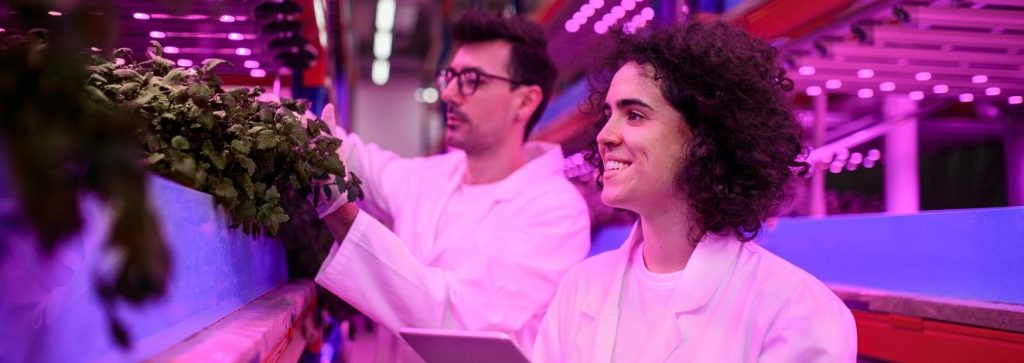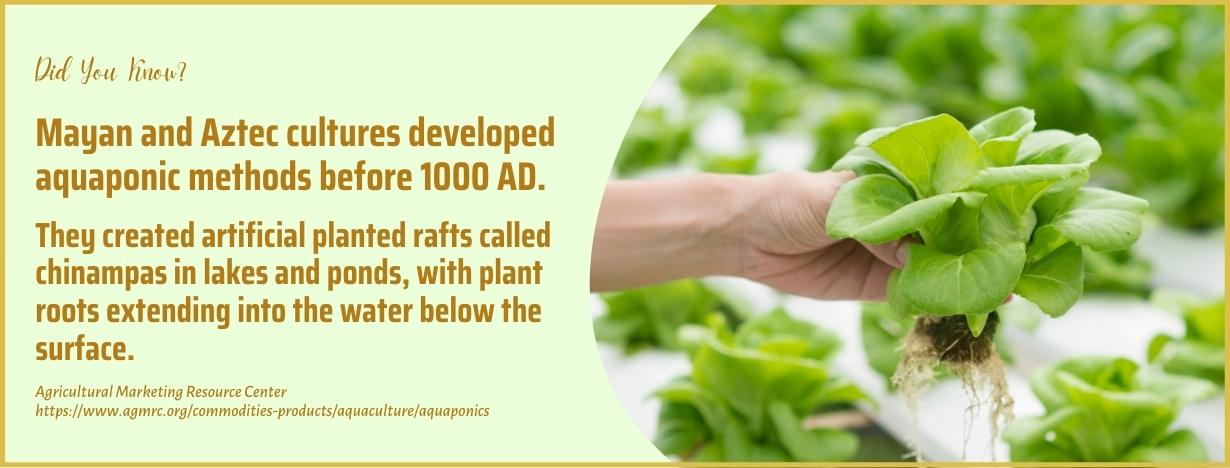5 Best Colleges That Teach Aquaponics
Find your perfect college degree
Aquaponics combines aquaculture (growing fish and other aquatic animals) and hydroponics (growing plants without soil) processes. These two are used in a symbiotic combination wherein the waster or discharge of the aquatic animals is fed to the plants.
Aquaponics systems are more integrated and complex than hydroponics, in which, aside from plants, aquatic animals like crawdads, worms, and fish are added.
The plants gather and use the waste products from the animals as fertilizer as this is packed with nutrients. During the whole process, water is purified so that it is reused by animals.
The Lowdown
Hydroponics and aquaponic systems directly fit into the STEM learning programs in high school, giving students the tools and knowledge they need to create a sustainable and healthy food production system.
Although aquaponics is part of the STEM program in high school, some colleges teach this field, others as a subject, and some integrate it into their agriculture curriculum.

Aquaponics is the combination of fish farming and growing plants in water. Through aquaponics, the nutrient-rich water produced by the fish is used to fertilize the plants, creating an effective and efficient ecosystem that is both sustainable and highly productive.
In addition, you may be interested in environmental management or marine biology!
Methodology:
To prepare this list of the best colleges offering Aquaponics programs, we considered the following aspects:
- Their ability to provide quality, highly-rated degree programs in the field of Aquaponics,
- Taught by qualified personnel who are experts in Aquaponics,
- Offers financial aid options,
- Has various learning formats to choose from,
- Provides proper accreditation, pursuant to the needs of an Aquaponics degree.
See our Methodology page for more information.
Check out these top programs today!
The Top 5 Colleges Offering Aquaponics Programs
College of Aquaponic Engineering and Design (AED)

Aquaponic Engineering and Design
This curriculum is now available on-demand where students will learn more about the business side of the industry: nutrition, food source, food production, how to raise fish in a controlled environment greenhouse, and many more.
- It is handled by Ryan Chatterson, a Molecular and Micro Biology graduate from the University of Central Florida, and has grown aquaponics for 15 years. He is well-versed in backyard systems, and commercial design fish tanks, and is currently managing two massive outdoor demonstration systems.
What Makes the Curriculum Unique:
Ryan Chatterson is a constant figure at Ohio State and has taught short courses in the school, as well as boot camps.
Did You Know?
Ohio State University’s College of Aquaponics Engineering and Design features expert advice from professionals and cutting-edge farm technology, thus providing you with the best aquaponic design systems that will surely work.
Utah State University

Aquaponics, College of Agriculture and Applied Science
USU’s Technology and Engineering Education (TEE) introduces its Aquaponics Lab, a teaching lab where students can apply integrative STEM concepts in raising fish and plant growth in a recirculating closed-loop system.
- The TEE Aquaponic Systems Lab of USU supports two courses: Aquaponic System (BPS) and Advanced Aquaponics.
- Students can complete the course regardless of the major they come from and can get hands-on experience in a controlled environment.
- Utah State University Aquaponics System meets the breadth requirement for physical science.
What Makes the Program Unique
USU’s College of Agriculture and Applied Sciences offers almost a hundred scholarship opportunities to students– not just 5, not 10, but 70 scholarships available!
Did You Know?
USU is one of the nation’s best land-grant, space-grant, and student-centered universities that lives by the principle that academics will always come first. It cultivates diversity of culture and thought by serving everyone through discovery and engagement, and learning, coupled with a strong and educated workforce.
The University of Wisconsin-Stevens Point

Aquaponics, College of Letters and Science
UW-Stevens Point is a leader in aquaponics education, offering the country’s first semester-long college aquaponics courses, master’s classes, and professional certificate programs for aquaponics.
- There are two available college courses via online lectures and discussions and in-person lab sessions.
- Courses cover advanced and basic concepts in biological systems design, aquaponics methods for science integration, and production technology.
What Makes the Program Unique
This covers a lot of courses that focus on foundational and help you develop applied knowledge of fish production and nutrition, crop selection, water chemistry, best management practices, water quality, good agriculture, food entrepreneurship, economics, business, and marketing.
Did You Know?
Students can earn 1-college credit or continuing education unit when they join the aquaponics master class, a 3-day continuing education workshop offered by Nelson and Pade, Inc., and in partnership with UW-Stevens.
The University of Maine

Center for Cooperative Aquaculture Research
Founded in 1999, the Center for Cooperative Aquaculture Research of the University of Maine introduced its aquaculture research and science development facility to address the needs of the aquaculture industry.
- This curriculum has various research fields, one of which is aquaponics systems.
- Back in 2014-2015, aquaponic systems expert Jeffrey Wall started a project inside the school’s greenhouse. The course aims at growing plants, crops, vegetables, and rainbow trout in a linked system.
- Worms were also raised with fish waste and compost to create the production of three new products: worm nutrient ‘tea’, worm castings, and the worms themselves. He was able to harvest trouts, kale, and spinach. Through proper marketing, the project eventually became a success for many CCAR visitors.
What Makes the Program Unique
Every year, the University of Maine conducts the 4-H At-Home Aquaponics Project, an online experiential learning course where a student can design, build, and maintain their aquaponic technologies.
Anybody can participate, no prior experience is required. Operating the project is also funded thru the Maine 4-H Foundation.
Did You Know?
The University of Maine Center for Cooperative Aquaculture Research is operating at a 22-acre shore of Taunton Bay in Franklin, Maine, just beside the USDA National Cold Water Marine Aquaculture Center. Both centers have the biggest and most advanced aquaculture development and research campus in the US.
Michigan State University

Aquaponics and Hydroponics
This involves using water-intensive systems in the production of plants and understanding the biology behind them. Students will dig deeper on fundamental topics, including maintaining water quality, water testing, and proper balance of nutrients.
- Teaching methods include lecture discussions, brainstorming, demonstrations, small group discussions, resort people, field trips, experiments, and supervised studies.
What Makes the Curriculum Unique
The curriculum is specifically designed for agriculture, food, and natural resources (AFNR) educators in Michigan and is grant-funded by the Michigan Department of Agriculture and Rural Development to support campus-based agricultural education.
Did You Know?
MSU, one of the top 100 research universities across the globe, is home to number 1-ranked graduate programs, innovative research centers, and a community of scholars and science enthusiasts.

Frequently Asked Questions
What are the types of Aquaponic Systems?
Because aquaponics typically uses the same systems as hydroponics, there is really no major difference in how the system works, except for the added fish tanks. Flood and drain, nutrient film technology, and water-submerged or deep cultural roots are compatible with merging with fish.
What aquatic animals can thrive in an Aquaponics System?
In aquaponics, freshwater fish is typically used. Barramundi and Tilapia are common options because they can tolerate diverse water conditions, and they also grow very fast. You can also use Trout for lower water temperatures.
What vegetables can grow in Aquaponics?
For small aquatic-based gardens that do not necessarily need heavy nutrient input, you can grow watercress, lettuce, arugula, kale, mint, decorative flowers, herbs, spring onions, okras, leeks, radishes, and spinach.
For the more advanced aquaponic systems, vegetables that require more nutrition are suitable. This includes tomatoes, cabbage, beans, broccoli, and cauliflower.
The Advantages of Knowledge in the Field of Aquaponics
- Sustainable Food Supply: Aquaponics systems are a sustainable way to produce fresh, organic vegetables, fruits, and fish. They use minimal resources such as energy, water, and land, and have a much smaller environmental impact compared to traditional farming methods.
- Low Maintenance: Aquaponics systems require little maintenance and upkeep, making them ideal for busy lifestyles. The water can be recycled over and over, and the integrated systems require minimal effort to keep the plants and fish thriving.
- Cost Savings: Since aquaponic systems make use of an existing environment and require minimal resources, they are inherently cost-efficient. These systems only require the purchase of the components used for cycling nutrients, such as a pump or aerator.
- DIY: Aquaponics systems are easy to build and can be scaled to fit any available space. While many purchase ready-made systems, it is possible to make one yourself with a few basic materials.
- Education Value: Because of their economic, environmental, and educational value, aquaponics systems are ideal for teaching people about the importance of the environment and sustainability. Growing food in an aquaponics system is an exciting and engaging way to learn about food production.
About Aquaponics:
Summary Points
- Take advantage of how efficient an aquaponic system is in growing food. Plants that are grown “aquaponically” use 95% less water than the conventionally grown ones. And since these plants are generally grown without soil, issues of soil erosion are now completely avoided, knowing how this is blamed for climate change.
- Implementing an aquaponics program in school is one way to enhance a school’s overall commitment and attitude toward caring for the environment and sustainability.
Additional Information:


